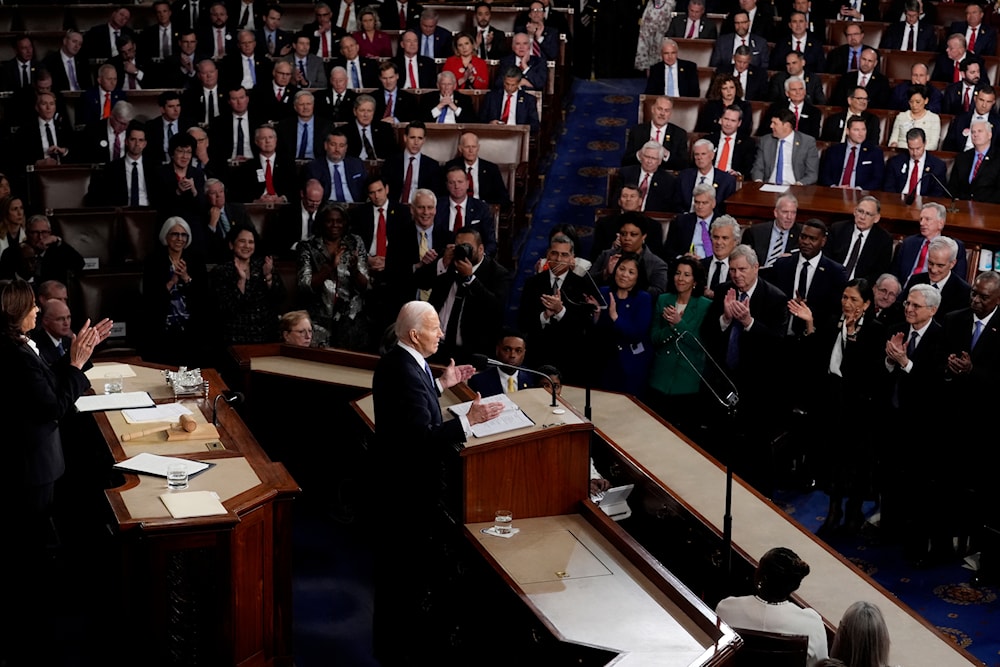US armed forces in a state of managed decline: WSJ
A report by The Wall Street Journal reveals Biden's new military budget cuts, showed that the US armed forces are in a state of managed decline.
-

President Joe Biden delivers his State of the Union address to a joint session of Congress, at the Capitol in Washington, Thursday, March 7, 2024. (AP)
US President Joe Biden began his State of the Union address by introducing a military budget reminiscent of 1991 during the final years of the Cold War as reported by The Wall Street Journal (WSJ).
However, the President's request for $850 billion for the Pentagon in 2025 represents a 1% increase over 2024. When adjusted for inflation, this amounts to a reduction, marking the fourth consecutive decrease proposed by Biden.
'US defense budget reductions'
Biden believes that it is an appropriate time to reduce the US defense budget, with the Administration citing compliance with budget caps negotiated with Congress last year, wrote the WSJ.
US army shrinks
The US Army will shrink, but not because America needs fewer land forces, which are in high demand in Europe and the Middle East. The Army is aiming for 442,300 troops, even though the Biden Administration requested 485,000 as recently as 2022. The ideal number for the required missions is 500,000. As reported by The Wall Street Journal, reducing the force size isn't enough to solve the underlying issue.
US Navy cuts
The US Navy will purchase only six ships and ten will retire early, which would decrease the fleet to 287 ships in 2025 from 296 today. That said, the Administration is set to purchase only one Virginia-class attack submarine, instead of two.
The Wall Street Journal reports that the US submarine technology is considered a crown jewel of US military power, however, the industrial base is struggling to produce two boats a year.
That said, purchasing only one submarine sends a negative message regarding capital investment and implies that the US is not committed to rearming. The US should aim to build 2.3 submarines per year to fulfill the Navy's requirements and provide submarines to Australia under the AUKUS pact.
US Space Force cuts
Regarding the US Space Force, the US must expand and strengthen its satellites in space to keep up with the global space race. However, the Biden budget intends to reduce the Space Force by $600 million compared to last year's request. This represents 2% of the force's budget, even as the services will need to fund a proposed 4.5% pay raise for troops.
The broader perspective depicted by this budget is that the US military is experiencing a managed decline, the WSJ reported. US defense spending is anticipated to decrease to 2.4% of the economy by 2034, down from an estimated 3.1% this year. Interest on the national debt will cost more than the US spends on defense this year, and the gap will continue to widen, The Wall Street Journal reported.
Read next: White House announces $300mln stopgap military aid plan for Ukraine
On another note, two days earlier, Biden released his budget request worth $7.266 trillion for fiscal year 2025, which includes frightening numbers forecasting a possible nuclear war in the coming years.
"The Budget provides $19.8 billion for Weapons Activities, $4.5 billion above the 2021 enacted level, to prioritize implementation of the 2022 National Defense Strategy and Nuclear Posture Review by modernizing the Nation’s nuclear deterrent to keep the American people safe," State Department said in a press release.
The request also includes $900 billion allocated for national defense, over $4.3 trillion designated for various programs, including Social Security, Medicaid, and Medicare, and $965 billion earmarked for servicing the interest on the national debt. Additionally, about $33.7 billion would be allocated for vital space capabilities, as stated by a senior US defense official.

 4 Min Read
4 Min Read








